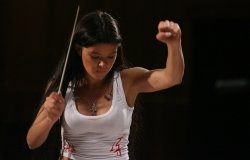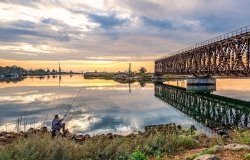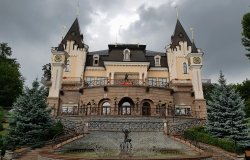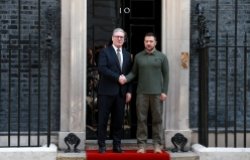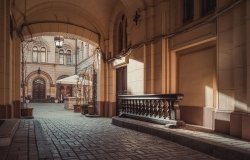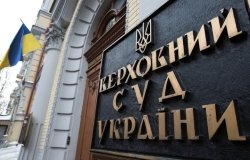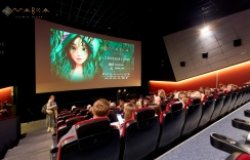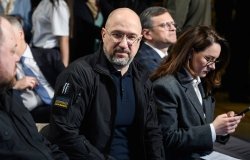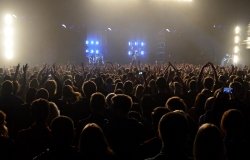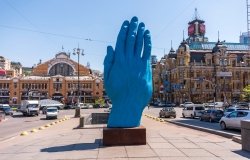
A blog of the Kennan Institute
Art Defending the Right of Ukrainians to Choose Their Own Destinies
Washington area art lovers have had ample opportunity in recent weeks to view stunning and moving new works from wartime Ukraine at two consecutive shows. The first, A Closer Look: Conflicted Art from Ukraine, ran at George Mason University’s Arlington exhibition gallery from May 31 through August 23. The second, WKWTA or We Know Who They Are, opened August 24 and runs through September 27 at Gallery 102 on the George Washington University campus, a few blocks from the State Department and the White House.
Together, the shows present several dozen new works by a score of artists. All produced since the full-scale Russian invasion in February 2022, the works use varied media and different genres, from lithographs, engravings, photographs, watercolors, acrylics, and oils, to metal and wood sculptures and repurposed war artifacts. One large work, Andrey Datura’s Diplomatic Arrangement, is painted in the artist’s own blood.
The creators are well-known and amateur, young and established, and male and female. They are geographically dispersed. But they all turned to art to express their deepest emotional responses to the war. A partial list includes Natalya Amirova, Alexander Bondarchuk, Anatoliy Kvitka, Nata Levitasova, Olena Papka, Roman Rabyk, and Vitalij Zdebskij.
Their subjects range from images of widespread destruction and moments of savagery to touching moments of human contact and overwhelming sadness, both personal and public. The images immortalize genocidal slaughter at Bucha and Irpin, touching railway farewells, and resurgent life against shattered cityscapes. A few turn a sad, wistful look at what has been lost; others share a wry poke at Russian politicians and their soldiers. Their emotional power ranges from terror and outrage to feelings of kindness and nostalgia for the familiar comforts of home.
Virginia IT specialist Yevhen Nemchenko collected the works beginning with the onset of the war (the very first air raid siren to be used in Kyiv is among the artifacts included in the WKWTA collection). Raised in Ukraine and in Russia, Nemchenko has relatives on both sides of the conflict.
Already collecting American art for a decade, he immediately understood the power of art at this moment. He reached out to friends and family in Ukraine to confirm that they were well. Then, he began acquiring art works being produced in response to the war. One purchase led to another, then another… His collection of several hundred items have become an invaluable historic record of the war and Ukraine’s profound societal and cultural responses to it.
Nemchenko has worked with numerous partners, including co-curators Sophie Bae, George Mason University collections manager; and Benjamin Cunningham, a George Washington University political science and fine arts student. Cunningham has partnered with Nemchenko and his wife Kristina in building the Conflicted Art collection.
This cooperative work will not stop when the exhibition at George Washington University closes. A book containing works in both exhibitions is available online. Plans are afoot to take the shows to Philadelphia and Chicago, and to make them available for touring to other galleries. Several are for sale. Moreover, Nemchenko will continue to build his collection for as long as hostilities continue.
Gallery materials from both venues explain why this art is of vital importance. The show at George Washington University reminds viewers on its website that “the Ukrainian art scene is vibrant and that the people of Ukraine are suffering but have a resolute will to protect their right to live, be free, and choose their destiny.” George Mason University’s organizers struck a more universal theme, with, “Conflict is often perceived as a natural part of human existence, yet there is a critical need for more comprehensive efforts to prevent its escalation into violence.”
The exhibits are a reminder of art’s power to raise resolve to protect the ability of humans in Ukraine and elsewhere to choose their destiny; and our collective need to do all we can to prevent the escalation of conflict into violence everywhere.
The opinions expressed in this article are those solely of the author and do not reflect the views of the Kennan Institute.
See our newest content first.
Subscribe to receive the latest analysis from Focus Ukraine.
About the Author

Blair A. Ruble
Former Wilson Center Vice President for Programs (2014-2017); Director of the Comparative Urban Studies Program/Urban Sustainability Laboratory (1992-2017); Director of the Kennan Institute for Advanced Russian Studies (1989-2012) and Director of the Program on Global Sustainability and Resilience (2012-2014)

Kennan Institute
The Kennan Institute is the premier US center for advanced research on Eurasia and the oldest and largest regional program at the Woodrow Wilson International Center for Scholars. The Kennan Institute is committed to improving American understanding of Russia, Ukraine, Central Asia, the South Caucasus, and the surrounding region though research and exchange. Read more



